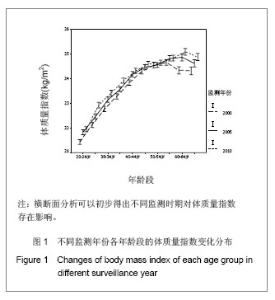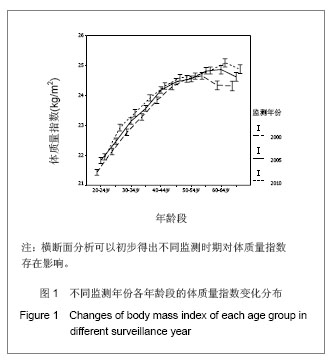Chinese Journal of Tissue Engineering Research ›› 2013, Vol. 17 ›› Issue (46): 8133-8140.doi: 10.3969/j.issn.2095-4344.2013.46.025
Ten-year prospective study on adult obesity in Jiangsu province
Li Sen, Huang Hui-ming, Xu Hao, Huang Jian-ya
-
Online:2013-11-12Published:2013-11-30 -
About author:Li Sen☆, Studying for doctorate, Assistant researcher, Jiangsu Institute of Sports Science, Nanjing 210033, Jiangsu Province, China lisenjstz@163.com -
Supported by:Projects of Science and Technology Support Program of Jiangsu Province, No. BE2010746*; Social Development Projects of Science and Technology Agency of Jiangsu Province, No. BE2012773*
CLC Number:
Cite this article
Li Sen, Huang Hui-ming, Xu Hao, Huang Jian-ya. Ten-year prospective study on adult obesity in Jiangsu province[J]. Chinese Journal of Tissue Engineering Research, 2013, 17(46): 8133-8140.
share this article
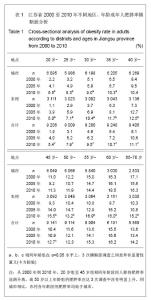
2.1 肥胖率横断面调查分析结果 通过对3次横断面调查的数据进行分析,结果如表1所示:总体来看,从20岁组至45岁组各相同年龄段间,2000年、2005年与2010年3次调查的成年人肥胖率差异均存在显著性意义(P < 0.05)。从2000年到2010年,相同年龄段间人群的肥胖率逐渐升高。而50岁以上年龄组的肥胖率在这3次调查中没有明显上升(P > 0.05)。另外,城市人群在20岁组到35岁组4个年龄段间出现随着调查年份的不同,肥胖率逐渐上升的趋势(P < 0.05),而在40岁以后肥胖率在这3次调查中没有明显增高(P > 0.05)。同城市相比,农村各年龄段的肥胖率均低于城市。但是农村人群在同一年龄组(从20岁组到65岁组)上,均表现出随着调查年份的变化,肥胖率逐次上升的变化趋势(P < 0.01)。因此农村将是今后防控肥胖率继续增长的重点地区。"
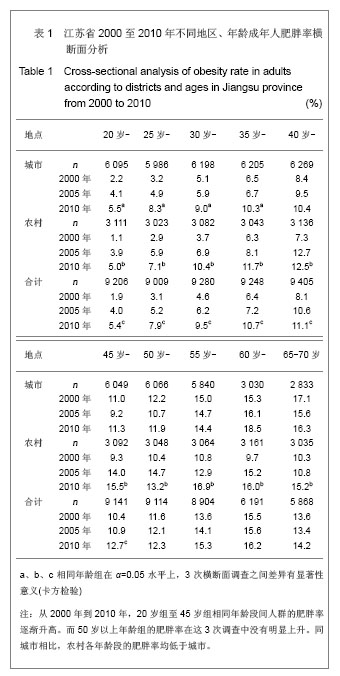
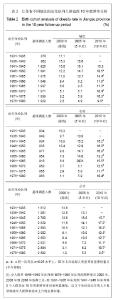
2.2 肥胖率出生队列分析结果 对1931-1935年队列到1976-1980年队列等10个队列的追踪分析,见表2。全人群从1946-1950年队列到1976-1980年队列的肥胖率从2000年、2005年到2010年逐渐上升(P < 0.05),提示在这7个年份段出生的人近10年来肥胖比例逐年升高,应该是控制肥胖的主要目标人群。而1931-1935年队列到1941-1945年队列等3个人群在近10年的肥胖率并没有明显增加,在这3个年份段出生的人不是导致成年人肥胖率逐年上升的主要对象。 另外,从城市和农村不同出生队列的肥胖率变化来看,城市的肥胖率从1946-1950年队列直到1976-1980年队列在近10年都是逐渐上升的(P < 0.05),但是农村从1941-1945年队列开始,直到1976-1980年队列都有肥胖率增高问题(P < 0.05),提示农村从1941年及以后出生的人都是肥胖高发人群,是控制肥胖增长的重点人群。而城市肥胖高发人群的最大出生年份要比农村年轻5岁,即从1946年及以后出生的人才是肥胖高发人群。"
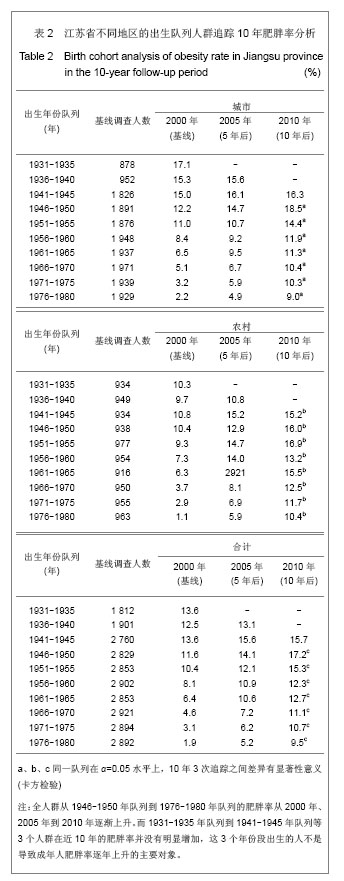
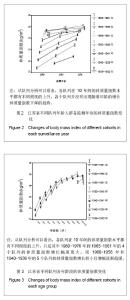
从横断面分析可以初步得出不同监测时期对体质量指数存在影响。另外,体质量指数还受年龄因素的影响。但是年龄对体质量指数的作用(横断面研究显示:55-60岁之前,体质量指数与年龄呈正相关,之后呈负相关的趋势),还需进一步通过队列研究来澄清。 2.4 体质量指数纵向队列分析结果 以5岁为年龄间隔,将调查人群分为10个出生队列(注:只有其中9个队列参与分析,1935-1931年队列没有追踪),即:1980-1976年队列、1975-1971年队列一直到1935-1931年队列。对这10个出生队列从2000年纵向追踪10年分析其体质量指数的变化见图2与图3。1980-1976年队列、1975-1971年队列、1970-1966年队列和1965-1961年队列4个人群的体质量指数从2000年到2010年10年间均有较为明显的上升,而1960-1956年队列、1955-1951年队列、1950-1946年队列、1945-1941年队列和1940-1936年队列5个人群的体质量指数从2000年到2010年10年间变化不大,没有明显的上升。 从队列分析可以看出,各队列在10年间的体质量指数水平都有不同程度的上升,只是其中1980-1976年到1965-1961年的4个队列的体质量指数增长幅度更大,而1960-1956年和1940-1936年的5个队列的体质量指数增长较小且增幅逐渐趋缓。但是各个队列均没有出现随着年龄的增长体质量指数下降的趋势。"

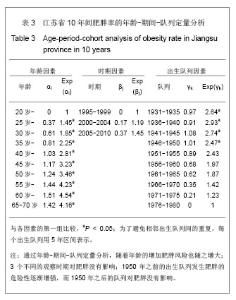
2.5 肥胖率年龄-期间-队列定量分析结果 从表3可以看出,以20-25岁组作为基准组,假设参数估计值等于0。25-30岁及以上年龄组随着年龄的增加,发生肥胖的危险性逐渐增大。OR值分别是20岁组的1.45倍、1.85倍、2.25倍、2.81倍……4.16倍。观察时期相比较,2000-2004年与2005-2010年观察时期的作用并不明显,而且与1995-1999年相比没有统计学差异。以1976-1980年出生队列作为基准组,假设参数估计值等于0。1951-1955年及其之后出生的队列发生肥胖的危险性逐渐减弱,而且这些队列与1976-1980年出生队列相比没有统计学差异。同1976-1980年出生队列相比,从1946-1950年队列到1931-1935年队列发生肥胖的危险性逐渐增强。在所有的出生队列中,1936-1940年出生的队列肥胖病的危险性最高。"
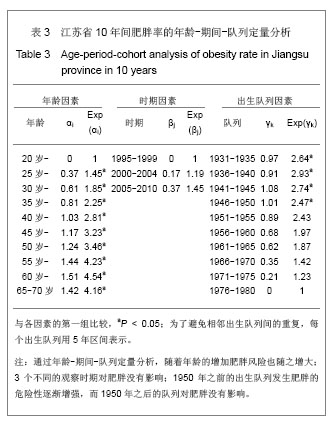
| [1]Must A, Jacques PF, Dallal GE,et al. Long-term morbidity and mortality of overweight adolescents. A follow-up of the Harvard Growth Study of 1922 to 1935. N Engl J Med. 1992; 327(19):1350-1355. [2]Berenson GS, Srinivasan SR, Bao W,et al. Association between multiple cardiovascular risk factors and atherosclerosis in children and young adults. The Bogalusa Heart Study. N Engl J Med. 1998;338(23):1650-1656. [3]Mahoney LT, Burns TL, Stanford W,et al. Coronary risk factors measured in childhood and young adult life are associated with coronary artery calcification in young adults: the Muscatine Study. J Am Coll Cardiol. 1996;27(2):277-284. [4]Katzmarzyk PT, Janssen I, Ross R,et al.The importance of waist circumference in the definition of metabolic syndrome: prospective analyses of mortality in men. Diabetes Care. 2006;29(2):404-409. [5]Li C, Ford ES, McGuire LC,et al. Increasing trends in waist circumference and abdominal obesity among US adults. Obesity (Silver Spring). 2007;15(1):216-224. [6]王惠君,翟凤英,杜树发,等. 1989~2000年中国九省成人体质指数分布的变化[J]. 卫生研究, 2006, 35(6): 794-797. [7]Kupper LL, Janis JM, Karmous A,et al. Statistical age-period-cohort analysis: a review and critique. J Chronic Dis. 1985;38(10):811-830. [8]Arbyn M,Van Oyen H,Sartor F,et al. Description of the influence of age,period and cohort effects on cervical cancer mortality by loglinear poisson models. Archives of Public Health. 2002;60(2):73-100. [9]Aitkin M, Anderson D, Francis B, et al. Statistical modeling in GLM [M] . Oxford: Oxford University Press, 1989. [10]武阳丰,马冠生,胡永华,等.中国居民的超重和肥胖流行现状[J].中华预防医学杂志, 2005,39(5):316-320. [11]覃羽乔,徐永芳,梁桂民,等.超重和肥胖与高血压、糖尿病的关系[J].中国公共卫生,2004,20(6):656-658. [12]Hu FB, Manson JE, Stampfer MJ,et al. Diet, lifestyle, and the risk of type 2 diabetes mellitus in women. N Engl J Med. 2001; 345(11):790-797. [13]中国肥胖问题工作组. 中国学龄儿童青少年超重、肥胖筛查体重指数值分类标准[J]. 中华流行病学杂志, 2004, 25(2): 97-102. [14]郭凤云,路紫. 基于空间分析方法的疾病地理研究进展[J].地理信息世界,2009,7(6):22-26. [15]Carstensen B. Age-period-cohort models for the Lexis diagram. Stat Med. 2007;26(15):3018-3045. [16]Hilbe JM. Generalized linear models. American Statistician. 1994;48(3):255-265. [17]Lahti-Koski M, Pietinen P, Heliövaara M,et al. Associations of body mass index and obesity with physical activity, food choices, alcohol intake, and smoking in the 1982-1997 FINRISK Studies. Am J Clin Nutr. 2002;75(5): 809-817. [18]Shen J, Goyal A, Sperling L.The emerging epidemic of obesity, diabetes, and the metabolic syndrome in china. Cardiol Res Pract. 2012;2012:178675. [19]World Bank. World Bank Development Indicators 2011. Washington, DC,USA, 2011. [20]Bell AC, Ge K, Popkin BM.The road to obesity or the path to prevention: motorized transportation and obesity in China. Obes Res. 2002;10(4):277-283. [21]Bauman AE, Reis RS, Sallis JF,et al. Correlates of physical activity: why are some people physically active and others not. Lancet. 2012;380(9838):258-271. [22]Breland JY, Fox AM, Horowitz CR,et al. Applying a common-sense approach to fighting obesity. J Obes. 2012; 2012:710427. [23]Heath GW, Parra DC, Sarmiento OL,et al. Evidence-based intervention in physical activity: lessons from around the world. Lancet. 2012;380(9838):272-281. [24]James WP. The fundamental drivers of the obesity epidemic. Obes Rev. 2008;9 Suppl 1:6-13. [25]Church TS, Thomas DM, Tudor-Locke C, et al. Trends over 5 Decades in U.S. Occupation-Related Physical Activity and Their Associations with Obesity. PLoS ONE.2011; 6(5): e19657. [26]Jacobsona SH, Kingb DM, Yuanb R. A note on the relationship between obesity and driving. Transport Policy. 2011;18(5):772-776. [27]Flemming K. Synthesis of quantitative and qualitative research: an example using Critical Interpretive Synthesis. J Adv Nurs. 2010;66(1):201-217. [28]Hammond RA, Levine R.The economic impact of obesity in the United States. Diabetes Metab Syndr Obes. 2010;3: 285-295. [29]Scarborough P, Bhatnagar P, Wickramasinghe KK,et al.The economic burden of ill health due to diet, physical inactivity, smoking, alcohol and obesity in the UK: an update to 2006-07 NHS costs. J Public Health (Oxf). 2011;33(4):527-535. [30]Xi B, Liang Y, He T, et al. Secular trends in the prevalence of general and abdominal obesity among Chinese adults, 1993-2009. Obes Rev. 2012;13(3):287-296. [31]Popkin BM, Adair LS, Ng SW. Global nutrition transition and the pandemic of obesity in developing countries. Nutr Rev. 2012;70(1):3-21. [32]Yu Y, Venners SA, Wang B,et al. Association of central adiposity with prediabetes and decreased insulin sensitivity in rural Chinese normal-weight and overweight women. Metabolism. 2010;59(7):1047-1053. [33]Wilks DC, Besson H, Lindroos AK,et al. Objectively measured physical activity and obesity prevention in children, adolescents and adults: a systematic review of prospective studies. Obes Rev. 2011;12(5):e119-129. [34]Sweet SN, Fortier MS. Improving physical activity and dietary behaviours with single or multiple health behaviour interventions? A synthesis of meta-analyses and reviews. Int J Environ Res Public Health. 2010;7(4):1720-1743. [35]Xin Z, Liu C, Niu WY,et al. Identifying obesity indicators which best correlate with type 2 diabetes in a Chinese population. BMC Public Health. 2012;12:732. [36]Sichieri R, do Nascimento S, Coutinho W. The burden of hospitalization due to overweight and obesity in Brazil. Cad Saude Publica. 2007;23(7):1721-1727. [37]Muennig P, Lubetkin E, Jia H,et al. Gender and the burden of disease attributable to obesity. Am J Public Health. 2006; 96(9):1662-1668. [38]Bray GA. Overweight is risking fate. Definition, classification, prevalence, and risks. Ann N Y Acad Sci. 1987;499:14-28. [39]Ye Y, Bao Y, Hou X,et al. Identification of waist circumference cutoffs for abdominal obesity in the Chinese population: a 7.8-year follow-up study in the Shanghai urban area. Int J Obes (Lond). 2009;33(9):1058-1062. [40]Ferreira I, Twisk JW, van Mechelen W,et al. Development of fatness, fitness, and lifestyle from adolescence to the age of 36 years: determinants of the metabolic syndrome in young adults: the amsterdam growth and health longitudinal study. Arch Intern Med. 2005;165(1):42-48. |
| [1] | Tang Jiping, Zhang Yeting. Exercise regulates adult hippocampal neurogenesis in Alzheimer’s disease: mechanism and role [J]. Chinese Journal of Tissue Engineering Research, 2022, 26(5): 798-803. |
| [2] | Song Yan, Zheng Kun, Wei Haoxin, Lu Dezhi, Xu Yuanjing, Wang Xiaowen, Wang Jinwu. reliability of flat feet evaluated by foot posture index and its application in three-dimensional printing insoles [J]. Chinese Journal of Tissue Engineering Research, 2022, 26(3): 344-349. |
| [3] | Liang Haoran, Zhou Xin, Yang Yanfei, Niu Wenjie, Song Wenjie, Ren Zhiyuan, Wang Xueding, Liu Yang, Duan Wangping. Pathogenesis of femoral head necrosis after internal fixation of femoral neck fractures in young adults [J]. Chinese Journal of Tissue Engineering Research, 2022, 26(3): 456-460. |
| [4] | Shang Wandi, Wang Xingze, Wei Xiaoyan. Effects of different types of abdominal support on lumbar-back muscle surface electromyography signals in people with abdominal obesity [J]. Chinese Journal of Tissue Engineering Research, 2022, 26(11): 1656-1661. |
| [5] | Fan Jiabing, Zhang Junmei. Morphological measurement and analysis of the mandible in adult females with different vertical skeletal types [J]. Chinese Journal of Tissue Engineering Research, 2021, 25(8): 1177-1183. |
| [6] | Wang Yongsheng, Wu Yang, Li Yanchun. Effect of acute high-intensity exercise on appetite hormones in adults: a meta-analysis [J]. Chinese Journal of Tissue Engineering Research, 2021, 25(8): 1305-1312. |
| [7] | Wang Xing, Xu Xuebin, Zhang Shaojie, Zheng Bingwu, Yang Xi, Wang Chaoqun, Li Ping, Ma Yuan, Li Kun, Chen Jie, Li Xiaohe, Shi Jun, Li Zhijun. Establishment and validation of C0-T1 finite element model of cervical vertebrae in adult rhesus monkeys [J]. Chinese Journal of Tissue Engineering Research, 2021, 25(35): 5632-5637. |
| [8] | Bu Jianhua, Wang Zhen, Liu Ziming, Li Lin, Yu Liang. Effect of calorie restriction and its combined exercise on fat reduction and irisin expression in obese rats [J]. Chinese Journal of Tissue Engineering Research, 2021, 25(35): 5638-5643. |
| [9] | Ye Erbai, Xiao Xiaoling, He Ziyu, Yang Chun, Du Yikuan. Peroxisome proliferator-activated receptor signaling pathway is involved in the metabolic regulation of obesity by intestinal flora and brown adipose tissue [J]. Chinese Journal of Tissue Engineering Research, 2021, 25(32): 5222-5226. |
| [10] | Zhong Ruixin, Gao Haiyan, Huang Haoran, Teng Xueren, Dai Shiyou. Anatomical features of anterior cruciate ligament on MRI in children, adolescents and adults [J]. Chinese Journal of Tissue Engineering Research, 2021, 25(30): 4812-4817. |
| [11] | Liu Jianguo, Pan Yong, Li Hanyu, Liu Yan, Zhang Zhentian, Lin Xiuping, Zhang Yuan, Liu Yajin, Zhang Fan, Zhang Leijun, Xiao Liehui, Xu Aimin, Zhu Cuifeng. Effect of microecological preparation combined with an improved low-carbon diet on fat metabolism and intestinal barrier function in obese patients [J]. Chinese Journal of Tissue Engineering Research, 2021, 25(29): 4672-4679. |
| [12] | Ren Sijun, Cao Zhipeng, Xu Rao, Ru Jiangying. Fixation of the modified Pauwels type Ⅲ femoral neck fractures in young adults with percutaneous hollow compression screw combined with medial buttress plate: 2-year follow-up [J]. Chinese Journal of Tissue Engineering Research, 2021, 25(27): 4354-4360. |
| [13] | Chen Ziyang, Pu Rui, Deng Shuang, Yuan Lingyan. Regulatory effect of exosomes on exercise-mediated insulin resistance diseases [J]. Chinese Journal of Tissue Engineering Research, 2021, 25(25): 4089-4094. |
| [14] | Wang Chaoge, Weng Xiquan, Lin Baoxuan, Chen Lina, Xu Guoqin. Exercises under cold exposure change fat type and function in obese rats [J]. Chinese Journal of Tissue Engineering Research, 2021, 25(20): 3162-3167. |
| [15] | Huang Zhusong, Lin Yu, Chen Xiang, Lan Jinfu, Guan Yong, Gao Xi. Alcohol extract of Morinda officinalis improves lipid metabolism and bone metabolism in ovariectomized obese rats [J]. Chinese Journal of Tissue Engineering Research, 2021, 25(2): 205-210. |
| Viewed | ||||||
|
Full text |
|
|||||
|
Abstract |
|
|||||
